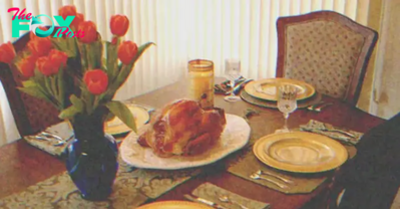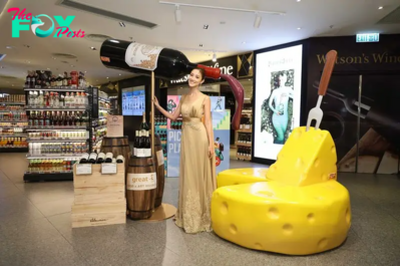Lifestyle
FAB Paris 2024: A look inside its new home in the Grand Palais
France’s premier fair for fine-art and antiques returns for its third edition inside its new home in the Grand Palais.
From an ancient Egyptian burial mask formerly in the collection of Gabrielle Chanel to furniture that once graced the salons of Versailles, Fine Arts La Biennale (FAB Paris) is back next month (November 22-27) with a stunning selection of works charting millennia of human endeavour and creativity. And, best of all – call it third time lucky – it returns under the glass dome of the newly restored Grand Palais, now the fair’s permanent venue. Transforming the historic space into a fabulous ephemeral museum, the show will encompass no fewer than 15 disciplines in the fields of fine art, furniture, antiquities and jewellery. And for those who like their art in the old-school variety, there’s Pieter Brueghel the Younger, Albert Dürer, Auguste Rodin, Renoir and Pablo Picasso.
FAB Paris (formerly known as Fine Arts Paris & La Biennale) was created in February 2022, in a move to combine the synergies, expertise and global reputation of two highly regarded French art fairs: La Biennale des Antiquaires and Fine Arts Paris. Ultimately, the aim of FAB, President Louis de Bayser tells us, “is to try to show very different aspects of the art market. And we’re trying as many surprises as possible. People come in and we want the visitors or the collectors to be surprised by some stands, to be surprised by some objects, to see new things, different things than in other fairs.”

In other words, FAB is a very different art animal from this month’s Art Basel Paris. “We don’t want to have a fair with 250 exhibitors. It’s not the aim,” De Bayser says. “The aim is to stay focused with maybe no more than 120 or 130 exhibitors, but always keeping in mind that we have to be strict on the quality, because it’s through that prism that people then judge the fair and return. I think when it’s too big, it’s tiring.”
Suitably engaged and curious, we ask what’s on his must-see list. “One speciality, which is really niche and surprising for people, will be Jean-Christophe Charbonnier. He’s showing a suit of Japanese armour and Japanese helmets. The objects are so delicate. The lacquer, the facial pieces, are made from iron, copper, gold, leather, silk, wood and even boar’s hair. The level of refinement is incredible, considering these were being used for war.”

Indeed, so “design” is the armour it might be a silhouette the late Issey Miyake or Rei Kawakubo would send down the catwalk – and you can almost trace contemporary design techniques back to this ornate, couturesque “battlewear”. It’s these types of discoveries that make FAB Paris such an enlightening and uplifting journey.
Charbonnier’s armour features in an offering of relative Japanmania. France and Japan have a long History of cultural exchange that dates back to the 16th century. The discovery of Japanese aesthetics and craftsmanship following the reopening of the Nippon Empire in 1853-54 radically transformed Europe’s visual culture. Japonisme became one of France’s most enduring artistic movements, profoundly iNFLuencing Impressionism, Art Nouveau and Art Deco. Similarly, in the 1920s and then the post-war era, many Japanese artists settled in France and took an active part in the Parisian art scene.
Fast forward to now and FAB welcomes Tokyo contemporary gallery A Lighthouse called Kanata, which will present minimalist works by celebrated Japanese sculptors and painters, such as Kan Yasuda, the last student of Isamu Noguchi and one of Japan’s greatest living sculptors.
It will also show Chiko.Takei, an emerging female Japanese artist in the nihonga tradition (using mineral pigments, and occasionally ink), who creates ethereal landscapes that are monotone, stark odes to the changing seasons not of climate but human memory. Her work glimmers with ephemeralities, nuances, and then fades and deliquesces like spring snow. Last but by no means least are Parisian female duo Louis & Sack who focus on post-war Japanese artists from the Nouvelle Ecole de Paris (Toshimitsu Imai, Key Sato, Hisao Domoto, Yasse Tabuchi, Kumi Sugai).
De Bayser then singles out one supreme entry point to a female narrative in 18th-century art – Marie Victoire Lemoine (1774-1821), showing through Brun Fine Art. Lemoine exhibited sporadically throughout her life, but was one of the few women in contemporary art who made a living from painting.
She studied with History painter François-Guillaume Ménageot, but is also said to have taken lessons from Élisabeth Louise Vigée Le Brun, (1755 -1842), who with her husband owned the building in which Ménageot and Lemoine lived and worked. Experts are increasingly seeing more of Le Brun in the work and less of Ménageot. Lemoine’s Young Woman Making Cheese (1802) is showing through Brun Fine Art.

For those not in the know, Vigée Le Brun, also known as Madame Le Brun, was Marie Antoinette’s portrait painter – or, at least, she depicted the royal patron on canvas in around 30 or so portraits, and the two became friends. She also painted actors, writers and other cultural luminaries of her time. She was much admired by Joshua Reynolds, who thought her work equal to anything by the Dutch Old Masters. Always innovative, and disliking High Rococo fashion of her time, she regularly “styled” her sitters, either changing their gowns entirely, or draping them in shawls and scarves and dressing them in grand hats and hairstyles, sometimes with feathers. It was a level of fashionista-ism John Singer Sargent would exude more than a century later.
Famously, Le Brun painted Self-portrait with Daughter Julie in 1787, in which she had the effrontery to smile, open-mouthed, and show teeth, a travesty in Paris art circles. “An affectation, which artists, art-lovers and persons of taste have been united in condemning, and which finds no precedent among the Ancients, is that in smiling, [Madame Vigée LeBrun] shows her teeth,” was one scathing review written of it. Simone de Beauvoir even denounced Le Brun as “narcissistic” in The Second Sex (1949).
Given that I’m speaking via Zoom from London to De Bayser in Paris, I’m keen to know his thoughts on the supposed preference for the City of Light’s art market over London in recent times. “I’d say there’s a movement from London to Paris, but it certainly doesn’t mean it’s the end for London,” he says. “I think in Paris there’s been a very good momentum in the last two or three years, and the dealers want to try to be part of this momentum and development, so that’s why they open spaces here. But that doesn’t mean they close the ones they have in London. I would say for us it’s good, because it gives a good dynamic to the market here in Paris. But there’s no specific bubble or anything in Paris. It follows the trends of the general market.”

And if there’s a trend in global art of late, it’s for Surrealism. A century on from André Breton’s founding manifesto, Surrealism still has the power to disrupt and inspire. In addition to prominent names, such as Max Ernst, Joan Miró and Alexander Calder, FAB’s offering aims to differentiate by highlighting lesser-known members of the movement, as well as contemporary artists iNFLuenced by the surrealist aesthetic.
Parisian gallerist Françoise Livinec presents works by friends and family
of André Breton, including his wife Jacqueline Lamba, and his son-in-law Yves Elléouet. French dealer Jean-François Cazeau highlights works by André Masson (1896-1987), one of the greatest exponents of automatic drawing and sand pictures, who’s just been given a retrospective at the Centre Pompidou, Metz.
And testament to the enduring iNFLuence of surrealism, works by British pop artist Clive Baber and young French artist Claire Trotignon, who creates fictional landscapes with fragments of antique prints, will also
go on view.
“I think the works of some of these painters, like Magritte, or Dali are fascinating creations. They’re so visually memorable, they’ve become like landmarks for 20th-century art,” says De Bayser. And the current predilection for surreal shows taps into the 21st-century zeitgeist for interest in the future post-human environments, and notions of post-apocalyptic devastation.
All of which is a far cry from another FAB highlight De Bayer references, the so-called “goût Rothschild”, a term coined to describe the sumptuous and erudite collecting style that was embraced across generations of the European dynasty since the 19th century.

Claire Trotignon, Paysage Acrobatique #5, 2024 
Claire Trotignon, Paysage Acrobatique #5, 2024 
Claire Trotignon, Paysage Acrobatique #5, 2024 
Villa Ephrussi de Rothschild
The fair is hosting a special exhibition dedicated to the Villa Ephrussi de Rothschild, the stately palace built by Béatrice de Rothschild (1864-1934) at Saint-Jean-Cap-Ferrat on the French Riviera. The show includes 50 decorative arts pieces from the property’s storied collection, many of which are showing publicly for the first time. The exhibition itself has been designed by Jacques Garcia, the interior designer who redecorated Versailles and the Louvre, among other high-profile projects.
“She wasn’t the biggest collector of her time, but she was an independent collector,” says De Bayser. “She bought from different places and was really choosing the works and living with them. It wasn’t like a museum, but the collection of a living person, changing, buying, selling; there’s a very nice bureau being exhibited which is very special.” Expect to see some Louis XVI clocks, and porcelain vases made for Madame de Pompadour (Louis XV’s mistress) among the attractions.
In a bid to keep FAB Paris active and forward focused, this year five young art dealers are being given the opportunity to exhibit at the fair. “FAB Paris was created by art dealers with the key mission to support the fine art and antique trade,” De Bayser reminds us. “Cultivating a new generation of art dealers is essential to the vitality of the market, and we hope this initiative will provide young talents from near and far with the opportunity to exhibit in a legendary venue, alongside some of today’s most eminent and experienced gallerists.” The prospective candidates must meet two requirements: being in Business for less than five years and present works estimated at less than €25,000.
Their artworks will go on view in a dedicated stand decorated by Victor Bonnivard, a young French interior architect known for his high-profile renovations of private residences, historic buildings, hotels in Paris and public spaces.
What are De Bayer’s aspirations for FAB 2024 and beyond? “You know, when we began Fine Arts, it was only paintings, drawings and sculpture. And year after year we developed the fair by increasing the number of specialities which were present. So first it was objets d’art, furniture, books and so on. And now we have a lot of specialities. Our aim is really to propose that at the end of November in Paris, you come and experience a snapshot of the art world, the art market and what is available for someone who’s interested in art.”
Which, on the strength of the fabulosity De Bayser refers to, makes me wonder who couldn’t be.
-

 Lifestyle1h ago
Lifestyle1h agoHOT NEWS: KELCE NOT HAPPY- Travis Kelce vents his anger UP over Chiefs first loss, That makes me angry..cau
-

 Lifestyle1h ago
Lifestyle1h agoI Couldn’t Reach out to My Husband for Days – Then My Mother-in-Law Called Me & Revealed the Shocking Truth
-

 Lifestyle1h ago
Lifestyle1h agoMy Stepmom Made Me Sleep in a Shed and Gave My Room to Her Kids — My Mom Immediately Brought Her Back Down to Earth
-

 Lifestyle1h ago
Lifestyle1h agoWoman Comes to Meet Her Fiancé’s Parents and Sees Another Woman Posing as Her at the Dinner — Story of the Day
-

 Lifestyle3h ago
Lifestyle3h agoBollywood hit 'Biwi No. 1' set to re-release in theatres | The Express Tribune
-

 Lifestyle3h ago
Lifestyle3h agoThe arena roars again | The Express Tribune
-

 Lifestyle7h ago
Lifestyle7h agoFans react after single Kim Kardashian hangs out with $30K Tesla robot: Low-maintenance boyfriend.cau
-

 Lifestyle7h ago
Lifestyle7h agoElon Musk: 53-Year-Old Welcomes Twelfth Member to His Growing Family and Everyone Says So.cau






























